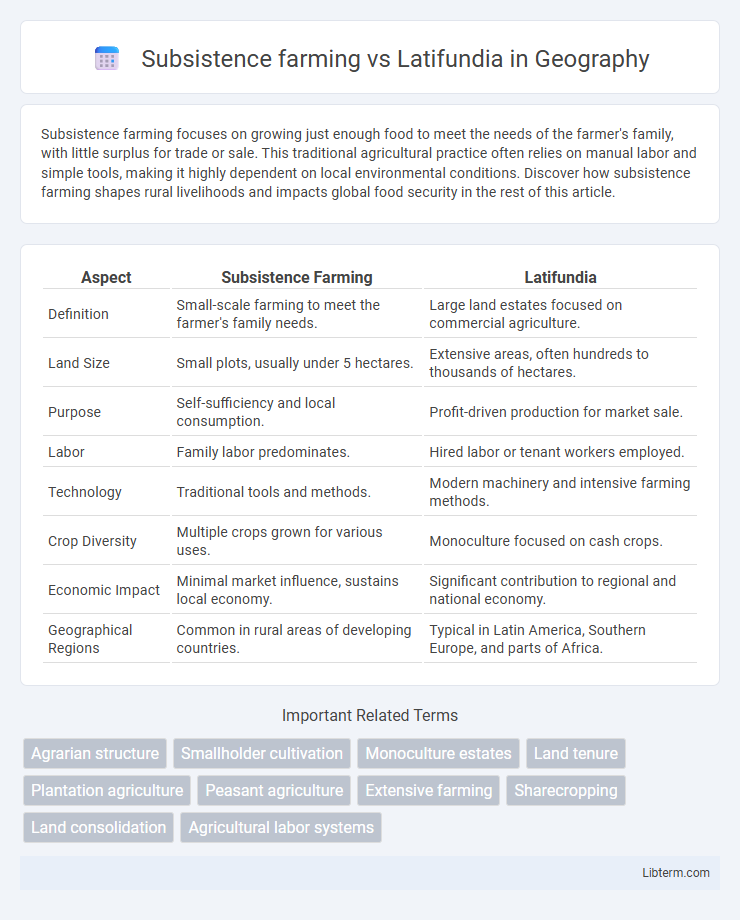Subsistence farming focuses on growing just enough food to meet the needs of the farmer's family, with little surplus for trade or sale. This traditional agricultural practice often relies on manual labor and simple tools, making it highly dependent on local environmental conditions. Discover how subsistence farming shapes rural livelihoods and impacts global food security in the rest of this article.
Table of Comparison
| Aspect | Subsistence Farming | Latifundia |
|---|---|---|
| Definition | Small-scale farming to meet the farmer's family needs. | Large land estates focused on commercial agriculture. |
| Land Size | Small plots, usually under 5 hectares. | Extensive areas, often hundreds to thousands of hectares. |
| Purpose | Self-sufficiency and local consumption. | Profit-driven production for market sale. |
| Labor | Family labor predominates. | Hired labor or tenant workers employed. |
| Technology | Traditional tools and methods. | Modern machinery and intensive farming methods. |
| Crop Diversity | Multiple crops grown for various uses. | Monoculture focused on cash crops. |
| Economic Impact | Minimal market influence, sustains local economy. | Significant contribution to regional and national economy. |
| Geographical Regions | Common in rural areas of developing countries. | Typical in Latin America, Southern Europe, and parts of Africa. |
Introduction to Subsistence Farming and Latifundia
Subsistence farming involves small-scale agriculture primarily aimed at producing food for the farmer's family, relying on traditional methods and minimal external inputs. Latifundia refers to large estates typically found in Latin America, characterized by extensive landholdings used mainly for commercial agriculture or livestock production. The distinction lies in scale, purpose, and economic structure, with subsistence farming supporting local sustenance and latifundia serving market-oriented demands.
Historical Origins and Evolution
Subsistence farming originated in ancient agrarian societies where small-scale, family-based cultivation focused on meeting immediate household needs without surplus production. Latifundia emerged during the Roman Republic, characterized by large estates controlled by wealthy landowners who exploited slave labor for commercial agriculture and export. Over time, subsistence farming persisted in rural communities worldwide, while latifundia systems evolved into modern large-scale agribusinesses, reflecting entrenched social inequalities and land concentration.
Land Ownership and Size Differences
Subsistence farming typically involves small-scale landholdings owned and cultivated by individual families for personal consumption, emphasizing self-sufficiency rather than profit. In contrast, latifundia are large estates owned by wealthy landlords or corporations, often spanning thousands of hectares, producing cash crops for commercial markets. The significant disparity in land size and ownership reflects socioeconomic inequalities and influences agricultural productivity and rural development in many regions.
Labor Practices and Workforce Characteristics
Subsistence farming relies heavily on family labor and small community involvement, emphasizing self-sufficiency with limited surplus for trade, often involving traditional, manual practices. Latifundia employ large-scale, hired labor forces, frequently including seasonal workers and sometimes exploitative labor conditions, prioritizing commercial production and efficiency. Workforce characteristics in latifundia reflect hierarchical organization with wage labor, contrasting subsistence farms' reliance on kinship-based labor systems.
Production Goals: Self-sufficiency vs. Profit
Subsistence farming centers on producing enough crops and livestock to meet the immediate needs of the farmer's family, prioritizing self-sufficiency over market sales. Latifundia, large commercial estates common in Latin America, focus on maximizing production for profit through extensive use of labor and capital-intensive methods. The stark contrast in production goals defines subsistence farming as a survival strategy, whereas latifundia operate as profit-driven agribusinesses.
Environmental Impact and Sustainability
Subsistence farming often relies on traditional methods with minimal external inputs, promoting sustainable land use but facing challenges like soil degradation and limited crop diversity. Latifundia, large-scale commercial estates, tend to prioritize monoculture and intensive resource extraction, leading to deforestation, biodiversity loss, and soil erosion. The environmental impact of latifundia is generally more severe, while subsistence farming aligns better with sustainable practices but may struggle to meet growing food demands.
Technology and Agricultural Methods
Subsistence farming relies on traditional agricultural methods and minimal technology, often involving manual labor and simple tools, which limits productivity and scale. In contrast, Latifundia employs advanced machinery, irrigation systems, and modern farming techniques to maximize output on large estates. The technological disparity results in higher efficiency and commercial surplus in Latifundia compared to the primarily self-sustaining production of subsistence farms.
Socioeconomic Effects on Rural Communities
Subsistence farming supports rural communities by promoting food self-sufficiency and preserving traditional agricultural practices but often limits economic growth and access to markets. Latifundia, large estates typically controlled by wealthy landowners, concentrate land ownership and wealth, leading to social inequalities and rural poverty. This land tenure imbalance exacerbates rural depopulation and restricts opportunities for smallholder farmers.
Role in Modern Agricultural Economy
Subsistence farming primarily supports local food security by producing just enough crops for the farmer's family with minimal surplus for trade. Latifundia, large estates typically owned by wealthy landlords, dominate commercial agriculture by leveraging scale, mechanization, and market integration to maximize profit. In modern economies, the contrast underscores subsistence farming's role in sustaining rural livelihoods versus latifundia's contribution to export-driven agricultural production and agribusiness growth.
Challenges and Future Trends
Subsistence farming faces challenges such as low productivity, limited access to modern technology, and vulnerability to climate change, which restrict food security and economic growth. Latifundia systems struggle with land inequality, environmental degradation, and socio-economic disparities, often resulting in inefficient land use and conflict. Future trends indicate a shift towards sustainable practices, land reform policies, and the adoption of agroecological techniques to enhance productivity and equity in both farming systems.
Subsistence farming Infographic

 libterm.com
libterm.com